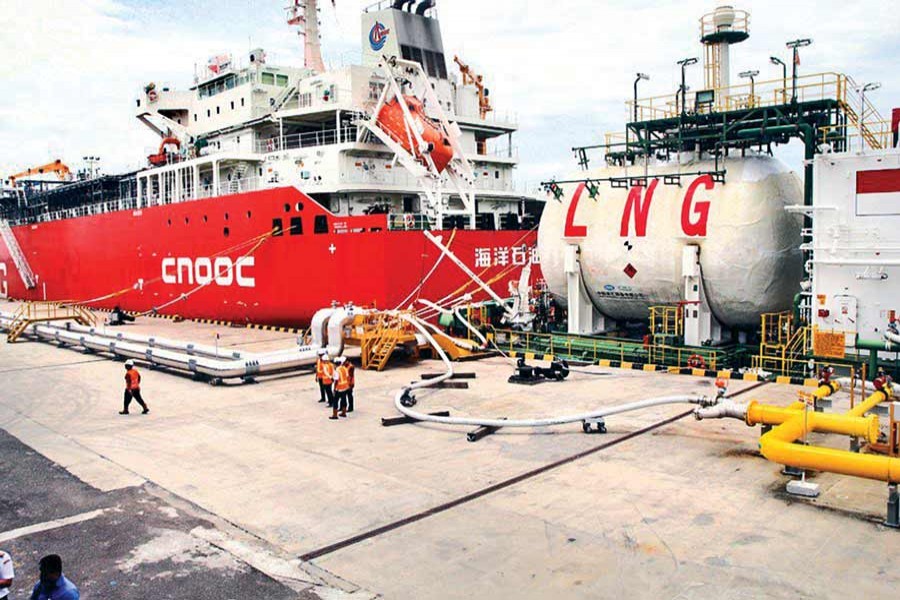 The emphasis is shifting to LNG with gas reserves depleting fast in Bangladesh.
The emphasis is shifting to LNG with gas reserves depleting fast in Bangladesh.  Bangladesh is set to see a big leap forward consolidating further the progresses in the power and energy sector from next year with the implementation of government plans already chalked out. Consumers' expense to avail the new power and energy solutions being offered by the government might also increase significantly as most of the new plans are involved with high tariff mechanisms.
Bangladesh is set to see a big leap forward consolidating further the progresses in the power and energy sector from next year with the implementation of government plans already chalked out. Consumers' expense to avail the new power and energy solutions being offered by the government might also increase significantly as most of the new plans are involved with high tariff mechanisms.
The country's electricity generation and overall supply situation have already improved significantly over the past one decade with the output reaching over 9,000 megawatt (MW), three times the electricity output of around 3200 MW one decade back.
Consumers are paying almost double the electricity tariff compared to what they paid around a decade ago as the tariff for retail-level consumers were hiked seven times as many new oil-fired power plants run on 'expensive' oil.
Although there was no significant improvement in the energy sector over the past one decade as the country has been suffering from acute natural gas crisis since 2009, the government has planned afresh to remove the crisis with the import of LNG (liquefied natural gas) from April, 2018 aiming to provide re-gasified piped natural gas to gas-guzzling consumers.
Inclusion of 'expensive' LNG in the import basket would certainly diversify the country's energy sources but it would escalate the energy costs so as the manufacturing costs in gas-guzzling industries.
Import of petroleum products is also set to grow further as the government has been awarding more oil-fired power plants to meet growing demand 'quickly.'
The government could increase the country's overall electricity generation riding mostly on 'expensive' oil-fired power plants as low-cost power plants continued to take time for coming online. The major fall in oil prices in the international market after 2012 turned out to be a boon for the country's power sector, which helped reduce overall oil import cost and restrained electricity generation cost.
Total installed capacity of the power plants is now 13,555 MW and their de-rated capacity to generate electricity is 12, 771 MW. Currently natural gas contributes around 61.69 per cent of the country's overall electricity generation, furnace oil around 21.26 per cent, diesel 8.31 per cent, coal 2.02 per cent and hydro 1.86 per cent. Eighty per cent of the country's overall population has access to electricity and per capita electricity consumption including the contribution of captive power plants is 433 units (kilowatt-hour).
Despite the growth the challenges in the country's power sector include high system losses, low efficiency of existing power plants, delays in completing base-load and low-cost power plants, low plant efficiency and erratic power supply. Diversifying energy sources for electricity generation is also important along with retiring of age-old and inefficient plants. Current power generation efficiency in gas-based plants is around 38 per cent, which can be raised to 45 per cent considering the international benchmark for a gas-based power plant. Oil-fired power plants are currently running at an average efficiency level of 36 per cent.
Power generation efficiency of captive power plants is much less, which is necessary to improve to check waste of resources.
Continuation of incentivising the private sector allowing them duty-free import of oil along with 9.0 per cent service charge and 'wholesale' extension of the tenure of 'inefficient' oil-fired power plants are, however, major concerns. Owners of rental-and quick-rental power plants bagged over Tk 392.26 billion as 'incentives' from the government over the past decade sans generating electricity.
The money was exacted by the private power sponsors in the form of 'capacity payment' stipulated in the contacts made with them when the government opted for a quick-fix solution to a nagging power crisis in the country. This amount is over 41.82 per cent of the total payments worth Tk 937.89 billion that the state-owned Bangladesh Power Development Board (BPDB) disbursed to all power producers against electricity purchase between July 2008 and December 2016. The remaining Tk 545.63 billion of the total was paid to all the power-plant owners as energy payments during the period under consideration.
Capacity payment is a sort of penalty, which the BPDB is bound to pay to the owners of rental-and quick-rental power plants, if the government fails to purchase a certain portion of electricity readily available with them.
The government had launched a drive to install several dozens of oil-fired rental-and quick-rental power plants from 2009, as a 'short-term' solution to a nagging countrywide electricity crisis. The government also awarded several gas-fired power plants to private-sector sponsors for building on a rental basis.
Most of these power plants were awarded under unsolicited offers under the Speedy Supply of Power and Energy (Special Provision) Act 2010. The law has a provision of immunity to those involved with the quick-fix remedies.
The government also allowed the private entrepreneurs duty-free import of furnace oil to run their power plants with 9.0 per cent service charge along with import costs as an incentive.
Alongside the rental power plants the government also had a plan to install a number of big peaking power plants as 'mid-term' and 'long-term' measures. The Power Division also then had planned to retire the rental-and quick-rental power plants after expiry of their initial tenures and bring down the electricity tariffs as well. But, instead of retiring 'expensive' rental-and quick-rental power plants, the government continued extending their tenures and installed more such plants with the capacity-payment and service charge provisions remaining intact as the mid-term power plants 'failed' to come online.
To tackle any 'disastrous' situation out of the failure of mid-term power plants coming online, the government recently approved awarding of 17 new diesel and furnace oil-fired power plants with the total capacity of 2,555 MW. They will go into operation in the next two years. The country's oil import volume, costs and electricity tariff are set to surge further as the consequences.
The country imports around 5.90 million tonnes of crude oil and refined oil combined annually, of which around 3.50 million tonnes are diesel and 1.50 million tonnes are furnace oil per year, to meet the domestic demand in various sectors, including power plants, irrigation, transportation and industries. Currently, Bangladesh has over 50 operational oil-fired power plants, being run with diesel and furnace oil. To meet the rapidly increasing demand for power and ensure stable supply the government has planned to build several big LNG-fired power plants to generate several thousand megawatts of electricity.
Against the backdrop of depletion of domestic natural gas reserve the government in 2010 had initiated the move to build an LNG import terminal to import the fuel, although it took long eight years to see the execution of the plan.
Bangladesh is currently dependent on onshore fields for overall gas output, with production hovering around 2,700 million cubic feet per day (mmcfd) against a demand for over 3,300mmcfd, according to state-owned Petrobangla. The country has a total of 26 discovered gas fields, of which gas is being extracted from 20 fields. Natural gas production in the country has been witnessing growth every year since its inception in 1971. But lack of necessary exploration and drilling work coupled with inadequate discovery of new reserves led to the crisis of natural gas.
To tackle the natural gas crisis the government has moved to start importing LNG from April 2018 and now making concerted efforts to move forward with building LNG import infrastructure.
The country's first LNG import terminal, a 3.75 million tonne per year capacity FSRU (floating, storage and re-gasification unit), being developed by the US-based Excelerate Energy, is expected to be commissioned in April 2018 and its second, also with a capacity of 3.75 million tonne per year, being developed by the Summit Group, is expected to be commissioned by the end of 2018. Both will be located at Moheshkhali Island in the Bay of Bengal, with ownership to be transferred to Petrobangla after 15 years of operation.
The government has also moved to build, by foreign firms, at least a couple of small FSRUs with a capacity of around 150-200 mmcfd, which are also planned to be readied by December.
These small FSRUs will be built adjacent to the jetties of the state-owned Chittagong Urea Fertiliser Company Ltd, and the multinationally-owned joint venture Karnaphuli Fertiliser Company Ltd (Kafco) on the River Karnaphuli under Chittagong Division.
Another small FSRU is planned to be built at the Sangu platform in the Bay of Bengal. Petrobangla has also planned to set up at least two onshore LNG terminals, each with a capacity of 7.5 million tonnes per year, by 2025.
Petrobangla on September 25 inked its first ever sales and purchase agreement (SPA) with Qatar's RasGas to import 2.5 million tonnes per year of lean LNG for 15 years. This state-run entity is eyeing to ink more SPAs as the country is in negotiation with four other potential LNG suppliers with whom it has inked MOUs to import LNG.
Gunvor Singapore Pte Ltd was the latest to sign MOU with Bangladesh or Petrobangla raising the number of such deals to five including that of Qatar, Switzerland-based AOT Energy and Oman.
Separately, Bangladesh is seeking to import spot LNG from suppliers taking the advantage of the downtrend in LNG pricing in the global market.
The country will need to import around 30 million tonnes of LNG annually to meet the mounting demand from various sectors including industries, power plants and fertiliser plants by 2041 as domestic gas reserves, according to a final draft of Bangladesh's Gas Sector Master Plan 2017, are depleting fast. Domestic natural gas production will peak at around 2.70 Bcf/d in 2017 before declining, the report said. The country's existing natural gas reserves of around 12 Tcf will completely run out by 2038 if no new exploration and discovery take place, said the report prepared by Copenhagen-based research firm Ramboll in association with Geological Survey of Denmark and EQMS Consulting Limited.
The government has already completed construction of its first dedicated pipeline to move re-gasified LNG to end-users and has three more in the making.
The 91 km (56 mile) 30-inch natural gas pipeline from Moheshkhali to Anowara, with a capacity of up to 800 mmcfd of gas has been completed and it has undergone the necessary testing. A parallel 79 km 42-inch pipeline is currently under construction to carry additional volumes of imported regasified LNG from Moheshkhali to Anowara, which is due for completion in 2018. Another 30-km 40-inch pipeline is under way to carry imported regasified LNG from Anowara to Fouzdarhat and supply it to end-users in the port city of Chittagong. Another 181 km 36-inch Chittagong-Feni-Bakhrabad gas transmission pipeline would also be installed soon to distribute supply across the country from Chittagong. Experts have predicted that the domestic natural gas prices might increase three-fold in next 10 years with the LNG import.
The writer is Special Correspondent at The Financial Express.
© 2024 - All Rights with The Financial Express
